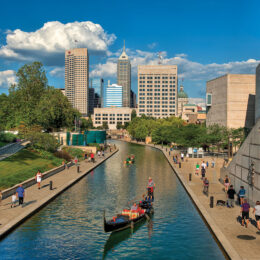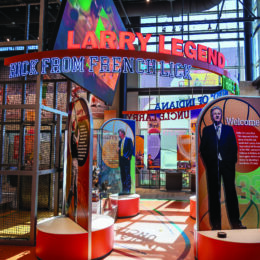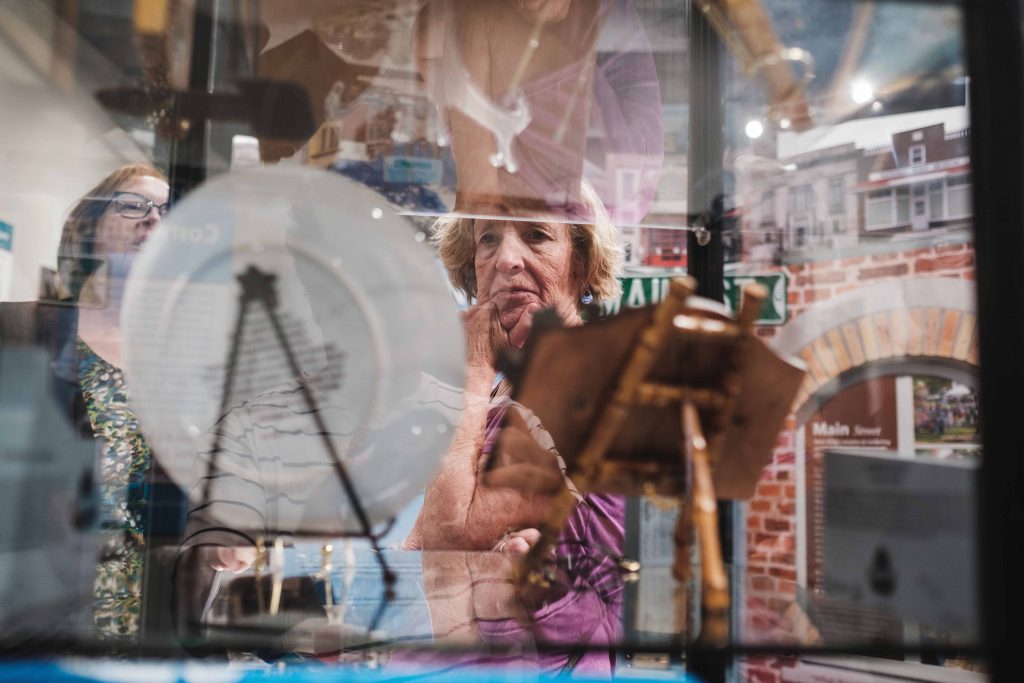
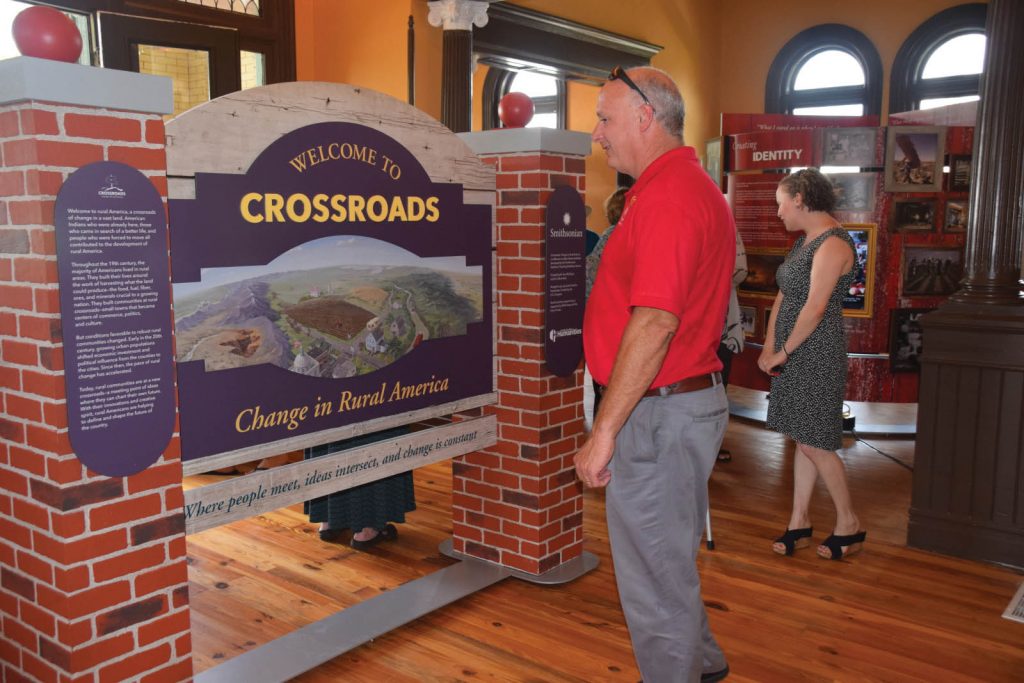
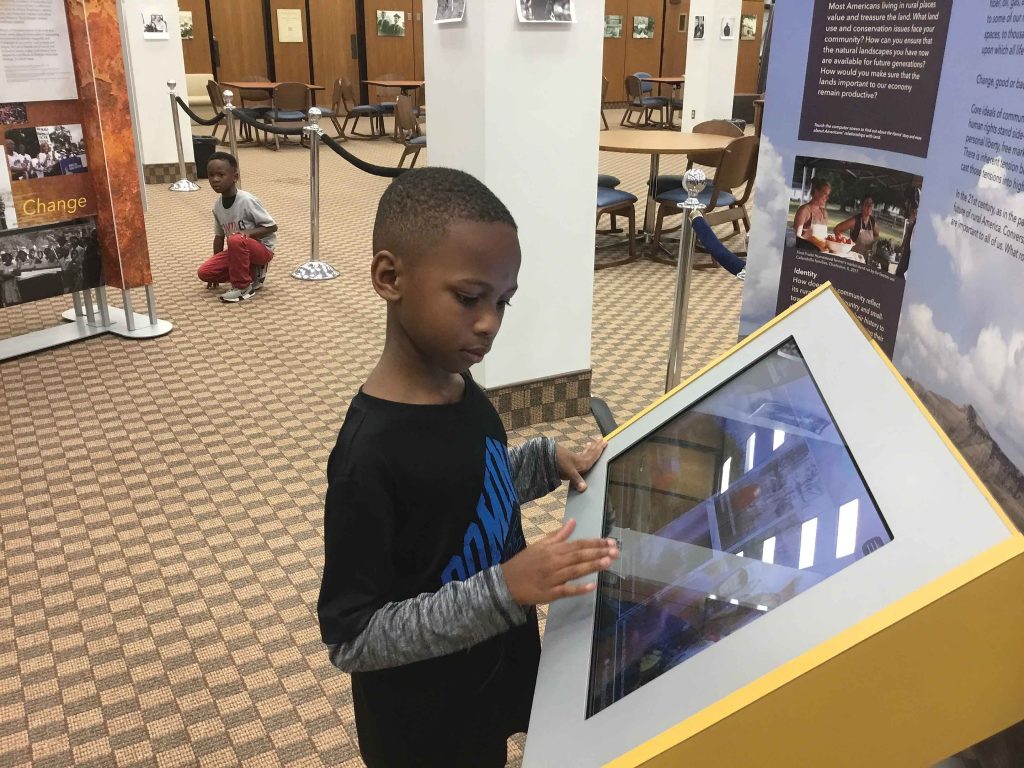
Visitors look over the national and local components of the “Crossroads” exhibit when it was in other states.
Two-lane highways steadily brought people to Dillsboro over the first half of the 20th century. Then interstates sped them away. What remains of the small southeastern Indiana town, like so many rural towns everywhere, are empty buildings, fading photos, memories — and dreams for a revival that still flicker within.
Now, a Smithsonian-curated traveling exhibit, “Crossroads: Change in Rural America,” hopes to bring people back to Dillsboro and five other specially selected rural Indiana communities. (see listing below)
The exhibit looks at the economic and social changes that have affected the fortunes of small towns over the past century. It explores how they adapted, identifies what makes them uniquely appealing, and fans discussions about the future. The exhibit opens this month at the Dillsboro branch of the Aurora Public Library, will spend six weeks in each of the six Indiana locations and will close in New Harmony in June 2020.
“Crossroads” is part of the Museum on Main Street program, a division of the Smithsonian that brings high-quality exhibits and resources to rural communities. Indiana Humanities, a statewide nonprofit dedicated to promoting the public humanities, helped bring the exhibit to Indiana and selected the six Hoosier hosts. Each of the six Hoosier communities will add its own local story to the exhibit.
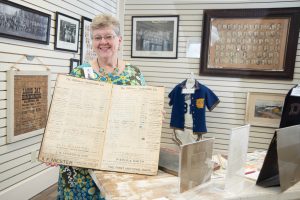
“We really had to brainstorm to see what made the biggest change in Dillsboro,” said Cathy Wilkymacky in developing the local theme. Wilkymacky is manager of the Dillsboro library branch. She wrote the town’s proposal for the exhibit and is also serving as the local project leader. “Everything led back to the roads — the change in the road patterns,” she said. “That’s what made the businesses end up closing. There was quite a big downtown area in Dillsboro, lots of shops and stores, groceries, clothing stores, furniture stores. The thing that was the deciding dagger to the businesses was really the improved transportation with I-74 and I-275 around Cincinnati.”
Running through Dillsboro is U.S. 50 — once a major East-West national highway. As traffic on the two-lanes trickled out with the completion of the new interstates, so did many towns across rural America. The building of suburban malls and national chain stores around nearby larger cities also hastened the closings on Main streets as rural residents found lower prices and more selection just a short drive away.
“Conversations about change in our rural communities are vital to the future of Indiana,” said Keira Amstutz, president and CEO of Indiana Humanities. “We are excited to be able to utilize the ‘Crossroads’ exhibition as a catalyst for dialogue around the past, present and future of rural Indiana.”
This is the first Smithsonian Main Street Program to come to Indiana. “Crossroads,” noted Megan Telligman, Indiana Humanities program manager, aligned well with Indiana Humanities’ current two-year initiative called “INseparable.” INseparable invites Hoosiers to explore how we relate to each other across boundaries, real or imagined, and consider what it will take to indeed be “inseparable.” “Crossroads” examines that urban-rural dynamic and how place affects identity.
Through community programs and creative activities, Museum on Main Street exhibitions and research are a launching point for storytelling and local pride.
“The people in this community are just so genuinely excited about the exhibit coming,” said Wilkymacky.
That community spirit doesn’t surprise her. “The pride in the community is just incomparable. The people that are from here, live here, are just are so involved and always wanting to do things to make it a better place.”
And while the exhibit is supposed to stimulate dialogue about the future, Wilkymacky said Dillsboro is already talking. She said the town has a revitalization plan in place, has developed things like a large farmer’s market and music programs, and is trying bring in new businesses and create an arts community.
“We hope the exhibit starts a statewide conversation,” said Telligman, “in Evansville and Indianapolis and Fort Wayne, and encourages people to take a little road trip through rural areas to see the changes happening in front of them and the potential they have to evolve and flourish.”
Smithsonian Institution exhibit coming to a Main Street near you
Hosts and dates for “Crossroads: Change in Rural America” in Indiana are:
• Sept. 7-Oct. 20: Dillsboro branch of the Aurora Public Library in Dearborn County
• Oct. 26-Dec. 8: Washington County Historical Society in Salem
• Dec. 14-Jan. 26, 2020: Jennings County Historical Society in Vernon
• Feb. 1-Mar. 15, 2020: Elkhart County Historical Museum in Bristol
• Mar. 21-May 2, 2020: North Manchester Center for History in Wabash County
• May 9, 2020-June 21, 2020: University of Southern Indiana/Historic New Harmony in Posey County
The six hosts also will curate a unique section of the exhibit that tells the story of their communities.
Another nine states were chosen to receive grants to develop programs, mini-exhibits and other projects related to the themes of the “Crossroads” exhibit.

